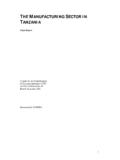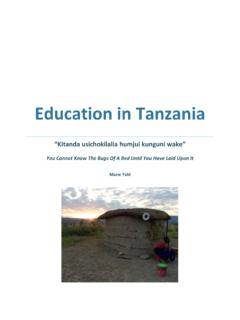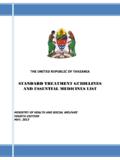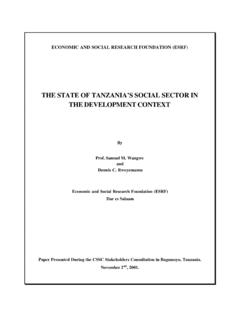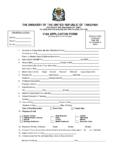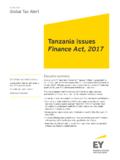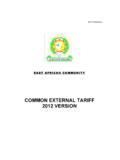Transcription of Tanzania assessment for scaling up nutrition - WHO
1 Tanzania Food and nutrition Centre Tanzania assessment for scaling up nutrition 2012 Foreword In June 2011 President Kikwete of Tanzania made commitments to scale up nutrition to the National Assembly and strengthened that commitment by joining the SUN Lead Group. The Prime Minister launched the National nutrition Strategy (NNS) in 2011 and formed the high level steering committee on nutrition . These are clear examples that the nutrition agenda has been strengthened and there is considerable interest in scaling up nutrition in Tanzania . Malnutrition is one of the most serious health problems affecting infants, children and women of reproductive age. Addressing this problem is thus crucial for a healthy nation. There are several on-going actions to rectify the problem but the burden is still considerable throughout the country.
2 Some of the main challenges are low birth weight, stunting, vitamin A deficiency, iodine deficiency disorders and anaemia. The Landscape Analysis is a participatory approach that seeks to identify gaps, constraints and opportunities for scaling up nutrition interventions and facilitates an analysis of existing capacities and resources available in the country. The analytical framework of the landscape analysis provides indicators for assessing readiness as a function of the critical components for success of commitment and capacity to scale up nutrition actions. This readiness analysis constitutes a systematic and scientific approach to assess where and how to best invest in order to accelerate action in nutrition , following the Lancet nutrition Series, where Tanzania was identified as one of the 36 high-burden countries accounting for 90% of the global burden of stunting.
3 It builds on the work and experiences of countries in developing and implementing national nutrition policies and plans developed as a follow-up to the 1992 International Conference on nutrition (ICN) and builds on interventions proven to be effective in addressing maternal and child undernutrition that are summarized in the WHO electronic Library of Evidence for nutrition Actions (eLENA). The Landscape Analysis in Tanzania involved key nutrition stakeholders in the public, civil society organizations, higher learning institutions, development partners and representatives from the regional and district levels. This participatory approach was crucial to foster ownership to the results and commitment to the recommendations.
4 Its findings will be used in the development of Implementation plan of National Nutritional Strategy and for guiding districts in scaling up implementation of nutrition interventions. Involving all sectors in the reduction of malnutrition by scaling up sectoral planning for nutrition interventions is crucial. Malnutrition can be reduced in Tanzania by a coordinated, multi-sectoral response from national to district and village level. Together we can fight Malnutrition. Acknowledgements This work was the product of six distinct stages of activities which involved many institutions and individuals. The stages of activities included 1. Desk review on nutrition situation, policies and previous assessments 2. Data collection and analysis at district level and discussion of findings with District Management Team 3.
5 National level interviews with key stakeholders 4. Participatory analysis and aggregation of results from all study districts and formulation of draft recommendations for discussion 5. Presentation of results at a stakeholders meeting on 6 March and agreement on final recommendations 6. Report writing We extend our sincere thanks to all individuals who were involved for their enthusiasm, advice technical and financial assistance. It is not our intention to leave the name of any person who contributed to make this work happen but it is due to space provided for acknowledgement. We sincerely thank all members of the task force established under the nutrition Multi-sectoral Technical Working Group with members from TFNC, WFP (Rosemary Mwaisaka), FAO (Vedasto Rutachokozibwa), UNICEF (Harriet Torlesse and Brenda Muwaga), COUNSENUTH (Dr.)
6 Lunna Kyungu) and USAID (Tanya Trevors). A process of development of the final report manuscript were done under leadership of Tanzania Food and nutrition Centre through collaboration with Dr. Mike Zangenberg of WHO Tanzania and Dr. Lunna Kyungu of Centre for Counselling, nutrition and Health Care (COUNSENUTH) as well as Dr. Faith Magambo of Tanzania Food and nutrition Centre (TFNC), Dr. Alfred Baraka Sanga, Dr. Onesmo Mella, Mr. Walbert Mgeni, Ms. Catherine Kimarandu, Mr. Fred Lwoga, Mr. Geoffrey Chiduo, Ms. Teddy Mamboleo all of TFNC, Mr. Clepin B Josephat of Ministry of Agriculture, Food security and Cooperatives, Dr. Peter Mamiro from Sokoine University of Agriculture. Lastly we thank and acknowledge the support and participation of the District Executive Directors and their staff of Rukwa, Makete, Lindi Municipal and Chamwino.
7 We are indebted to WHO for financial support for this work and TFNC as the leader for assessment task force. Finally we are indebted to the partners participating in the interviews from central Ministries (PMO, PMO-RALG, MoAFSC, MoHSW, MOCDG and TBS), bilateral donors (USAID, IrishAid, DFID, World Bank), UN agencies (UNICEF, WFP, FAO, WHO), NGOs (HKI, COUNSENUTH, Africare, World Vision, URC, Save the Children, AMREF and the regional and district authorities and communities where this nutrition Landscape Analysis conducted. Contents Foreword .. 2 Acknowledgements .. 3 Contents .. 4 Abbreviations .. 6 Background .. 8 Overview of nutrition 8 nutrition situation in Tanzania .. 10 Multiple of causes of malnutrition in Tanzania .)
8 10 Under 5 and infant mortality and morbidity .. 11 Stunting .. 12 Low birth weight .. 14 Underweight .. 14 Wasting .. 14 Maternal BMI .. 15 Exclusive Breastfeeding (EBF) .. 15 Anaemia .. 16 Vitamin A .. 16 Iodine .. 17 Objectives and methodology .. 18 Previous assessments .. 22 Results .. 23 Summary .. 23 Commitment to accelerate action in nutrition .. 24 Awareness of nutrition problems among stakeholders .. 24 Awareness of underlying causes among stakeholders .. 25 Political commitment .. 25 nutrition coordination mechanisms at central level .. 26 nutrition coordination mechanisms at sub-national level .. 29 nutrition policies, strategies and action plans .. 29 Planning and budgeting .. 30 Mapping of partners and their interventions .. 33 Implementation of nutrition activities in the facilities.
9 35 Capacity to accelerate action in nutrition .. 37 Availability of nutrition Officers/Focal Persons .. 37 Capacity building and support .. 37 Pre-service training .. 38 In-service training .. 39 Availability of training opportunities and plans .. 39 Health worker confidence, capacity, motivation and support .. 40 Health worker knowledge and confidence .. 41 Protocols, IEC material and supplies .. 44 nutrition indicators and use of nutrition data .. 45 Recommendations .. 47 References .. 51 Annexes .. 52 Policy mapping .. 52 Assessments highly relevant for the joint assessment .. 59 Stakeholder meeting, 6th March 2012 .. 66 Abbreviations AIDS Acquired Immune-Deficiency Syndrome ASDP Agriculture Sector Development Programme BCC Behaviour Change Communication BFHI Baby Friendly Hospital Initiative BMI Body Mass Index CAADP Comprehensive Africa Agriculture Development Programme CCHP Comprehensive Council Health Plan CFSNA Comprehensive Food Security and nutrition assessment CORPS Community Owned Resource Persons COUNSENUTH Centre for Counselling.
10 nutrition and Health Care CPA Certified Public Accountancy CSO Civil Society Organisation DALDO District Agriculture and Livestock Development Officer DCDO District Community Development Officer DED District Executive Director DEO District Education Officer DMD Coordination of Prime Minister s Office DMO District Medical Officer DPLO District Planning Officer DPs Development Partners ECD Early Child Development ENA Essential nutrition Action FANC Focused Antenatal Care FAO Food and Agriculture Organisation FSIT Food Security Information Team FSNA Food Security and nutrition assessment GoT Government of Tanzania HBC Home Based Care HIV Human Immuno-deficiency Virus HKI Helen Keller International HLSC High Level Steering Committee HMIS Health Management Information System IDD Iodine Deficiency Disorders IEC Information Education and Communication IMCI Integrated Management of Childhood Illness IPC Integrated Food Security Phase Classification ITN Insecticides Treated Nets IYCF Infant and Child Feeding IYCN Infant and Young Child nutrition LBW Low Birth Weight LFSNIS Livelihoods-based Food Security and nutrition Information Systems LGAs Local Government Authorities MAFC Ministry of Agriculture, Food and Cooperative MAFSAN Mapping Actions for Food Security and nutrition MAM Mild Acute Malnutrition MCDGC Ministry of Community Development Gender and Children MDAs Ministries.











